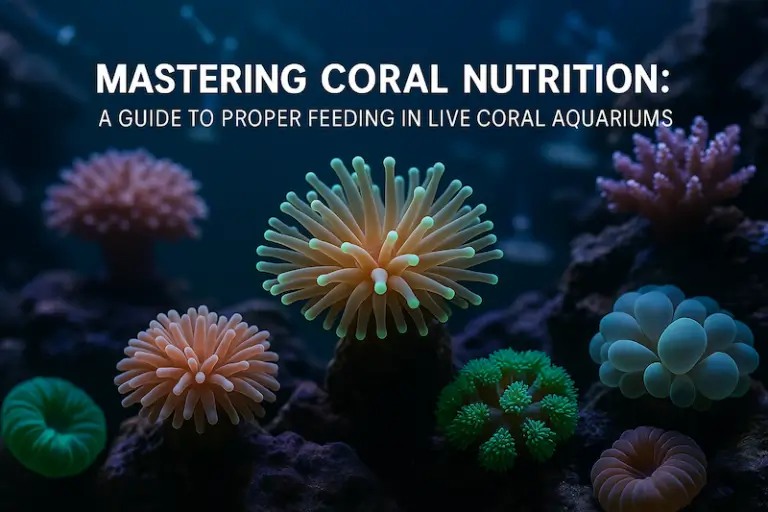What Causes Coral Bleaching? A Deep Dive for Reef KeepersUnraveling the Mystery of Coral Bleaching in Live Coral Aquariums
Coral bleaching is a devastating phenomenon that occurs when corals expel the algae living in their tissues, causing them to turn completely white. This is often a response to environmental stressors like high water temperatures, pollution, or changes in water chemistry. In live coral aquariums, understanding and preventing coral bleaching is crucial to the health and longevity of your coral reef ecosystem.
🧪 Causes of Coral Bleaching
Coral bleaching is one of the most distressing events that can occur in a reef aquarium. It doesn’t just affect the appearance of your corals—it’s often a signal that something is seriously wrong in their environment. Bleaching happens when corals expel the symbiotic zooxanthellae algae living in their tissues, which not only strips them of their vibrant colour but also deprives them of a major energy source.

🧯 Common Causes of Coral Bleaching in Aquariums:
🔥 1. Elevated Water Temperatures
- One of the most common triggers.
- A consistent temperature above 27–28°C (81–82°F) can stress corals.
- Even a brief spike in temperature can cause bleaching, especially in sensitive species like Acropora or Euphyllia.
Related Article: Too Hot To Handle? How To Keep Your Aquarium Ahead Of The Heat!
💡 2. Excessive or Intense Lighting
- High PAR (Photosynthetically Active Radiation) levels, especially sudden increases, can “burn” corals.
- A common mistake is placing new corals too high in the tank under strong LEDs without acclimation.
Tip: Gradually acclimate corals to lighting changes using dimming features or mesh screens.
🌡️ 3. Rapid Parameter Swings
- Changes in alkalinity, calcium, salinity, or pH can lead to stress.
- Ideal ranges should remain stable as much as possible, even more so than being “perfect.”
🧪 4. Poor Water Quality
- High nitrate or phosphate levels can lead to oxygen imbalances or encourage algae overgrowth.
- On the flip side, too low nutrients (ULNS systems) can also starve zooxanthellae and result in pale or bleached corals.
💨 5. Lack of Proper Flow
- Inadequate water movement leads to localized heat and poor gas exchange.
- Euphyllia and other large polyp stony (LPS) corals rely on gentle but steady indirect flow.
Related Article: Fast Or Slow? Your Guide To Water Flow!
⚠️ 6. Chemical Contamination or Toxins
- Household cleaners, metals from equipment, or coral warfare toxins can all stress coral colonies.
- Even resin leach from faulty plumbing parts has been known to trigger bleaching events.
💊 7. Disease or Pest Infestation
- Coral-eating flatworms, nudibranchs, and bacterial infections can irritate or stress corals into expelling their zooxanthellae.
- Symptoms often include localized bleaching, tissue recession, or polyp retraction.
📝 Summary:
Coral bleaching is a defense mechanism triggered by stress. The key to prevention is consistency and observation. If your corals start turning pale or white, act fast: check temperature logs, test water parameters, assess lighting, and rule out contamination or pests.
🧠 Pro Tip: Always quarantine new corals and use light acclimation protocols to reduce stress before introducing them into your main display.
Preventing Coral Bleaching
There are several steps you can take to prevent coral bleaching in your live coral aquarium. Maintaining stable water temperatures, proper lighting levels, and regular water quality testing are key factors in preventing coral stress. Additionally, avoiding sudden changes in water parameters and providing proper flow and nutrients to your corals can help them withstand potential bleaching events.
Recognising and Responding to Bleached Corals
If you notice signs of coral bleaching in your live coral aquarium, it is important to take immediate action. Bleached corals are more vulnerable to disease and may struggle to recover without intervention. By closely monitoring your corals and water parameters, you can identify bleaching early and make changes to mitigate further damage.

Restoring Bleached Corals
Once corals have bleached, it is possible to help them recover if caught early enough. Providing optimal water conditions, reducing stressors, and offering supplementary nutrients can aid in the recovery process. However, it is essential to act quickly and diligently to give your corals the best chance of survival.
Conclusion
Understanding the causes, prevention, and response to coral bleaching is crucial for live coral aquarium enthusiasts. By taking proactive measures to protect your corals and recognising the signs of bleaching early, you can help maintain a thriving and resilient coral reef ecosystem in your own home aquarium.








